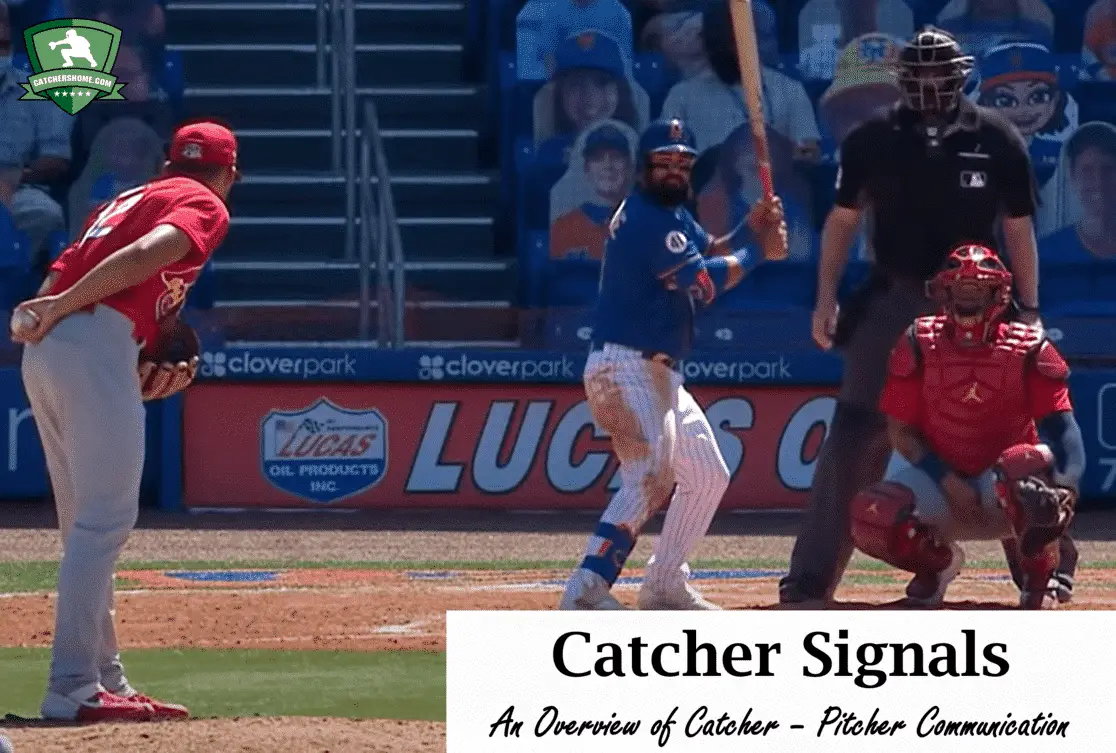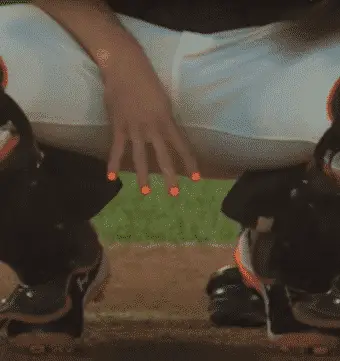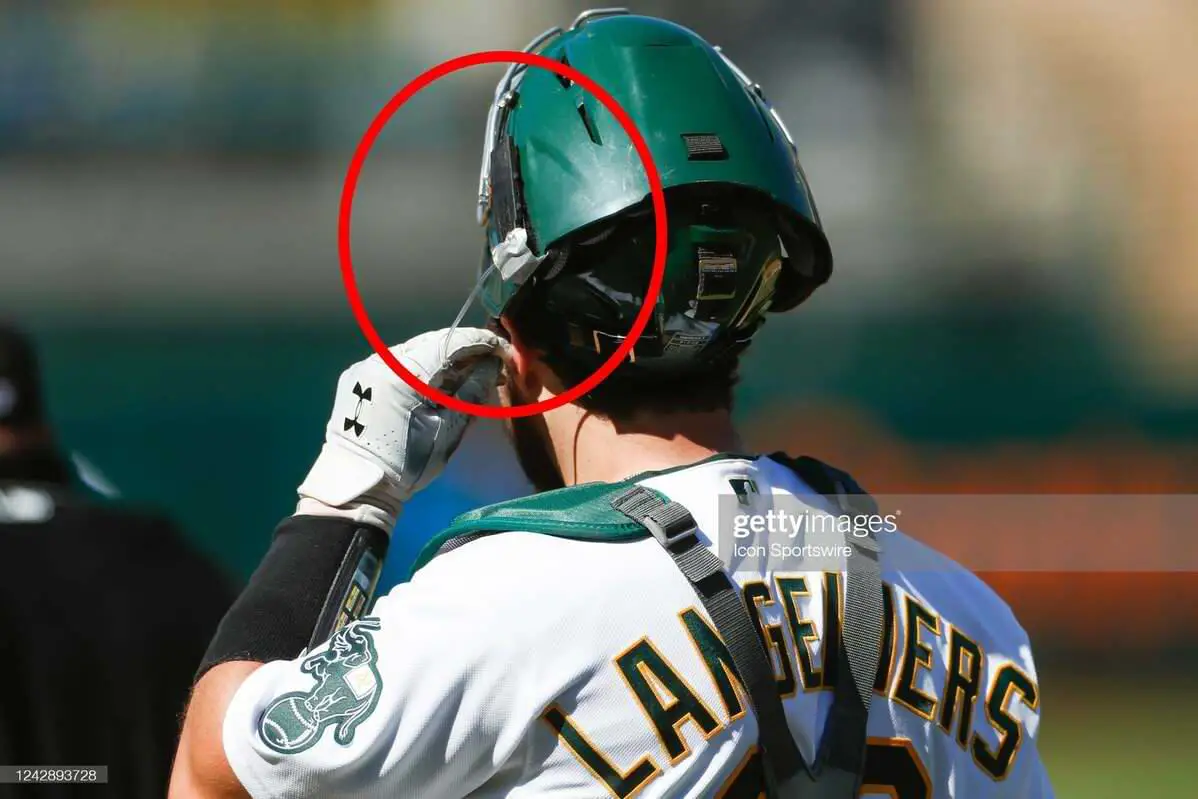Though you may not always see or hear it, communication between a catcher and a pitcher is constant during a game.
Silent communication like this is accomplished by using a system of hand signs, most important of which is a catcher’s signs to the pitcher.
In this post we’ll highlight basic catchers signals signs and principles for making catcher - pitcher communication effective.
Keep scrolling to learn more...

This post may contain affiliate links. Please see our disclaimer for more information.
Please note: The following post focuses on signals between catchers and pitchers. It does not get into other types of catcher-related communication, such as pitching signs from a coach to a catcher or signs from the catcher to infielders.
An Overview of Catcher Signals
Communication is important wherever we are, whether at home, school or work. It’s no surprise that communication is also critically important in sports like baseball and fastpitch softball.
This is generally understood. People get it.
What they might be surprised about is how baseball and softball players - specifically, catchers and pitchers - communicate.
These two positions work incredibly closely together. That’s where the baseball terms “battery” and “batterymate” came from.
Yet pitchers and catchers can't simply speak verbally to each other. For one, the other team would immediately understand what the next pitch will be. Secondly, stadiums hold thousands of fans and it would be difficult for each player to hear one another.
So how do baseball or softball catchers and pitchers communicate?
You guessed it. Through signals.
Since catchers have the best seat in the house, they pass the most information to the pitcher.
Why Catcher Signals are Needed
A good pitcher needs to have several things going for them. They must be strong physically and mentally.
They need to be able to put the ball exactly where they want it.
Their arm must be healthy with no major limitations in movement.
And, of course, a pitcher needs to be able to get the ball over the plate consistently and at a high rate of speed.
What isn't required is that a pitcher have eyes in the back of his or her head.
One reason a catcher communicates with a pitcher is to keep the pitcher aware of what is going on behind them.
Another reason for signals is so each batterymate knows the type and general location of pitch that is coming. If they get this wrong, it can lead to some awkward situations. Check out the below video to see what we’re talking about.
Common Principles to Remember
Catchers are often seen giving signals to the pitcher as he or she squats behind the plate.
It seems simple enough on the surface, but there are a lot of things the catcher needs to do right - as well as avoid. For example:
- When giving signals with your fingers, use your throwing hand. Obviously, there isn't enough time to spend taking your catcher’s mitt off, signing, and putting it on again!
- Squat. This allows you to put your hand in between your legs so the whole world can't see what signals you're sending.
- Don't squat too wide. Keep your knees just wide enough that the pitcher, and perhaps the middle infield, can see your signal fingers.
- Signal with purpose, as if you're giving your phone number to someone using hand signals. Make each sign easy for the pitcher to see.
Basic Signs From the Catcher to the Pitcher
Catchers give signals to their pitcher by pointing between their legs toward the ground.
The basic baseball catcher signs that a catcher gives to his or her pitcher are:
- Fastball: one finger (typically the index finger)
- Curveball: two fingers
- Slider: three fingers
- Change up: four fingers
Specific pitches can vary based on the unique set of pitches that a pitcher throws, but generally speaking, the signs mentioned above are the most universally used.
If, for whatever reason, the pitcher is having trouble seeing the catcher hand signals clearly, it can be helpful to make a simple tweak such as painting white out on your fingernails.
You can also get brightly colored stickers designed for this purpose, such as this set of “signal enhancement” stickers on Amazon. As an example, former MLB catcher Buster Posey was known for using similar stickers for giving pitch signals.

When to Start Giving Signs
If you’re brand new to the catcher position, below are some general rules of thumb to help with communication and signaling to the pitcher.
- Make sure you don't signal until the batter ISN'T looking at you. Yeah, we know that’s simple. But it had to be said.
- Let the hitter get in the box and get ready before you sign.
- Be sure to talk to your pitcher before the game. Do you want to stick with the signals you have? Has anything changed? Remember, communication and personal leadership as a catcher is critical!
- Is a relief pitcher on the mound? If so, stop at the mound for a few seconds. Make sure you're both on the same page with the signals to use.
- Don't begin giving hand signals until the pitcher is on the rubber and looking at you.
Other Methods for Communicating to the Pitcher
Fingers aren't the only things catchers have to work with when it comes to communicating with a pitcher.
For example, when catching, a quick touch to your thigh can tell a pitcher where to place the next pitch.
Another way to communicate pitch location is to use two signs. This approach involves the catcher giving one hand sign to the pitcher to indicate the pitch, followed by a second number to communicate location.
To illustrate this, pretend a catcher and a pitcher agree before the game that even numbers will mean an outside pitch and odd numbers will mean an inside pitch.
When the first batter steps up to the plate, the catcher gives the pitcher a one (1) followed by a two (2).
What’s that pitch? It’s a fastball to the outside.
Lastly, a catcher may be worried about their signals being figured out by the other team.
If this is a concern, then the catcher can choose to make his or her signs more complicated, or they can use a key which they will have to use first before the sign becomes “real”.

Let's Talk About PitchCom
PitchCom exploded onto the scene in the MLB in 2022. It quickly became one of the most popular ways for big league catchers to give signs to their pitchers.
Generally speaking, it works by sending signals over two electronic transmitters - one with the catcher and one with the pitcher.
The reason it's growing in popularity is because it's a simple way to communicate pitch type without the risk of the other team stealing the sign.
If you watch an MLB game these days, you may notice the catcher punching buttons on a black device located near the top of his leg guard. That's PitchCom.
He will also have a white cord coming out of his helmet near his cheek. That's part of PitchCom as well.
If you're interested in learning more about this, check out our article on earpieces used by catchers.

More Than Just a Pitch
Catchers also use signs to communicate with pitchers about more than just which pitch to throw.
Other things catchers can tell pitchers using hand signs include:
- They can signal to the pitcher to try and pick a runner off.
- If they suspect a runner is about to steal, the catcher can signal to throw a pitch-out.
- They can signal to the pitcher to hold the runner. Basically, take their foot off the rubber and make a move to the base without throwing.
Keep it Simple
One of the most important things catchers need to remember about giving signs to a pitcher is to keep it simple! If signing becomes too complicated or confusing, it can defeat the purpose.
It also can’t be stressed enough - make sure a catcher and pitcher are on the same page about signals to use. Good communication and chemistry between batterymates can have a big influence on a game’s outcome.
Frequently Asked Questions
The following are a list of basic questions about catcher signs that are commonly asked.
Question: Who is the player who gives signals to the pitcher?
Answer: The player who gives signals to the pitcher is the catcher.
Catchers often look to their coach to call a specific pitch. This explains why you may notice catchers looking to the dugout immediately after getting in their stance.
In these cases, what the catcher is doing is simply relaying the pitch that the coach called by signaling to the pitcher using his or her hands.
Question: How do pitchers and catchers communicate?
Answer: Pitchers and catchers communicate with one another for the purpose of calling pitches in one of two primary ways.
The first is using catcher hand signals that communicate to the pitcher the type of pitch to throw. This is a tried and true method that pitchers and catchers across a variety of leagues have been using for decades.
The second is to use an electronic communications system, such as PitchCom. This is a newer method involving an electronic transmitter and receiver that began being broadly adapted in the MLB in 2022.
Question: Why do catchers signal pitchers?
Answer: Catchers signal pitchers to secretly inform them of the type of pitch to throw.
The goal is for the pitcher to throw the right kind of pitch in a particular situation or count, and to do so in a way that keeps the opposing team in the dark about the pitch type that is coming.
Question: Does the catcher tell the pitcher what to throw?
Answer: In some cases catchers tell the pitchers what to throw. In other cases, catchers simply relay the pitch that the coach wants thrown.
The type of approach that is used depends on a number of things, including but not limited to a coach or manager's tendencies, the specific game situation, or the catcher's experience and ability to call the game.
Question: Do pitchers give signs to catchers?
Answer: Pitchers do not give signs to catchers. It's catchers who give signs to pitchers.
Typically the only type of "signing" pitchers do when it comes to calling pitches is to acknowledge with a head nod the pitch that is being called, or a quick shake of the head to call for a different type of pitch.
Thanks for Reading
We hope this information was helpful to you.
If you have any questions for us feel free to reach out by heading over to the Contact Us page or send us an email to scott [at] catchershome [dot] com.
Thanks for stopping by Catchers Home!
Scott Perry
Scott Perry is the owner and lead author at Catchers Home. He's a former baseball player, a current coach, a husband and a Dad. He remains as passionate about baseball today as he was as a kid.

